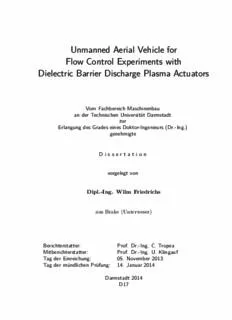
Unmanned Aerial Vehicle for Flow Control Experiments with Dielectric Barrier Discharge Plasma PDF
Preview Unmanned Aerial Vehicle for Flow Control Experiments with Dielectric Barrier Discharge Plasma
Unmanned Aerial Vehicle for Flow Control Experiments with Dielectric Barrier Discharge Plasma Actuators Vom Fachbereich Maschinenbau an der Technischen Universität Darmstadt zur Erlangung des Grades eines Doktor-Ingenieurs (Dr.-Ing.) genehmigte D i s s e r t a t i o n vorgelegt von Dipl.-Ing. Wilm Friedrichs aus Brake (Unterweser) Berichterstatter: Prof. Dr.-Ing. C. Tropea Mitberichterstatter: Prof. Dr.-Ing. U. Klingauf Tag der Einreichung: 05. November 2013 Tag der mündlichen Prüfung: 14. Januar 2014 Darmstadt 2014 D17 Bitte zitieren Sie dieses Dokument als: URN: urn:nbn:de:tuda-tuprints-37765 URL: http://tuprints.ulb.tu-darmstadt.de/id/eprint/3776 Dieses Dokument wird bereitgestellt von tuprints, E-Publishing-Service der TU Darmstadt. http://tuprints.ulb.tu-darmstadt.de [email protected] DieVeröffentlichungstehtunterfolgenderCreativeCommonsLizenz: Namensnennung - Keine kommerzielle Nutzung - Keine Bearbeitung 3.0 Deutschland http://creativecommons.org/licenses/by-nc-nd/3.0/de/ Hiermit erkläre ich, dass ich die vorliegende Arbeit, abgesehen von den in ihr ausdrücklich genannten Hilfen, selbständig verfasst habe. Darmstadt, den 05.11.2013 Abstract DielectricBarrierDischarge(DBD)plasmaactuatorsarearelativelynovel type of actuators for active flow control. They offer several benefits, such asfastreactiontimesduetotheabsenceofmechanicalparts. Ontheother handthereareseveraldifficultieswhichmustbeovercomebeforetheyreach a stage of maturity suitable for application on aircraft. In the present study the design, construction and commissioning of an Unmanned Aerial Vehicle (UAV) for flow control experiments with plasma actuators under realistic flight conditions is presented. The UAV has a wingspanof2.38mandaflightmassofapproximately10kg.Itisequipped with a flight control system to autonomously conduct the experiments and record measurement data. The fault-free operation of all systems, despite electromagnetic emissions from the high-voltage system of the actuators, and the suitability of the UAV as a flight-test platform have been demon- strated. Two sections of the modular wing are used for flow control, different air- foil and actuator configurations can thus be interchanged. The attainable Reynoldsnumbersareintherangeof300,000to600,000.Validationofthe entire system with several configurations has been performed in the wind tunnel prior to free-flight experiments. i ii Kurzfassung Dielectric Barrier Discharge (DBD) Plasma-Aktuatoren sind eine relativ neue Art von Aktuatoren zur aktiven Strömungskontrolle. Sie bieten eine Reihe von Vorteilen, wie ihre schnelle Reaktionszeit aufgrund des Fehlens von mechanischen Teilen. Andererseits gibt es einige Problematiken, die überwundenwerdenmüssen,bevorsieeinenfürdieVerwendungaufFlugzeu- gen erforderlichen Reifegrad erreichen. IndervorliegendenArbeitwirddaherdieEntwicklung,Konstruktionund Inbetriebnahme eines Unmanned Aerial Vehicle (UAV) zur Durchführung von Experimenten zur Strömungskontrolle mit Plasma-Aktuatoren unter realen Flugbedingungen beschrieben. Das UAV hat eine Spannweite von 2,38 m und eine Flugmasse von circa 10 kg. Zur automatischen Durch- führungderExperimenteundMessdatenerfassungistesmiteinemFlugkon- trollsystem ausgerüstet. Die störungsfreie Funktion aller Systeme, trotz elektromagnetischerEinstreuungdurchdasHochspannungssystemderAk- tuatoren, und die Eignung des UAV als Messplattform wurden gezeigt. ZweiSegmentedesmodularaufgebautenFlügelswerdenzurStrömungs- kontrolle genutzt, verschiedene Flügelprofile und Aktuatorkonfigurationen können so verwendet und gegeneinander ausgetauscht werden. Die hierbei erreichten Reynoldszahlen liegen im Bereich von 300.000 bis 600.000. Vor Experimenten im Freiflug wurde eine Validierung des Gesamtsystems mit verschiedenen Konfigurationen im Windkanal durchgeführt. iii iv Acknowledgements I would like to thank my doctoral advisor Prof. Dr.-Ing. Cameron Tropea forprovidingtheopportunityofpursuingtheresearchleadingtothisthesis. I am grateful for the advice and support over the years from him and Dr.- Ing. Sven Grundmann. Furthermore, I would like to thank Prof. Dr.-Ing. Uwe Klingauf for refereeing this thesis. IamtrulygratefultoallcolleaguesandtheworkshopteamsattheCenter ofSmartInterfacesandtheInstituteofFluidMechanicsandAerodynamics in Griesheim for their advice and support. Special thanks go to Johannes Meyer from the Institute of Flight Systems and Automatic Control for his patience and ongoing help with the flight control system and Ralf Kaiser for enablingthe flight experiments. Furthermore, I would like to thank my students, who with their work fundamentally contributed to this study. Theresearchleadingtotheresultspresentedinthisworkwasconducted aspartofthePLASMAEROproject. Theprojecthasreceivedfundingfrom the European Community’s Seventh Framework Programme FP7/2007- 2013 under grant agreement n◦234201. Further support has come from theDeutscheForschungsgemeinschaftthroughExcellenceClusterEXC259 ’Smart Interfaces’. v vi
Description: